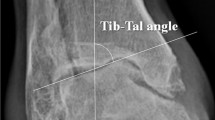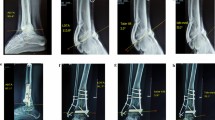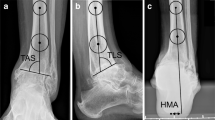Abstract
Background
Patients with ankle arthritis often present with concomitant hindfoot deformity, which may involve the tibiotalar and subtalar joints. However, the possible compensatory mechanisms of these two mechanically linked joints are not well known.
Questions/purposes
In this study we sought to (1) compare ankle and hindfoot alignment of our study cohort with end-stage ankle arthritis with that of a control group; (2) explore the frequency of compensated malalignment between the tibiotalar and subtalar joints in our study cohort; and (3) assess the intraobserver and interobserver reliability of classification methods of hindfoot alignment used in this study.
Methods
Between March 2006 and September 2013, we performed 419 ankle arthrodesis and ankle replacements (380 patients). In this study, we evaluated radiographs for 233 (56%) ankles (226 patients) which met the following inclusion criteria: (1) no prior subtalar arthrodesis; (2) no previously failed total ankle replacement or ankle arthrodesis; (3) with complete conventional radiographs (all three ankle views were required: mortise, lateral, and hindfoot alignment view). Ankle and hindfoot alignment was assessed by measurement of the medial distal tibial angle, tibial talar surface angle, talar tilting angle, tibiocalcaneal axis angle, and moment arm of calcaneus. The obtained values were compared with those observed in the control group of 60 ankles from 60 people. Only those without obvious degenerative changes of the tibiotalar and subtalar joints and without previous surgeries of the ankle or hindfoot were included in the control group. Demographic data for the patients with arthritis and the control group were comparable (sex, p = 0.321; age, p = 0.087). The frequency of compensated malalignment between the tibiotalar and subtalar joints, defined as tibiocalcaneal angle or moment arm of the calcaneus being greater or smaller than the same 95% CI statistical cutoffs from the control group, was tallied. All ankle radiographs were independently measured by two observers to determine the interobserver reliability. One of the observers evaluated all images twice to determine the intraobserver reliability.
Results
There were differences in medial distal tibial surface angle (86.6° ± 7.3° [95% CI, 66.3°–123.7°) versus 89.1° ± 2.9° [95% CI, 83.0°–96.3°], p < 0.001), tibiotalar surface angle (84.9° ± 14.4° [95% CI, 45.3°–122.7°] versus 89.1° ± 2.9° [95% CI, 83.0°–96.3°], p < 0.001), talar tilting angle (−1.7° ± 12.5° [95% CI, −41.3°–30.3°) versus 0.0° ± 0.0° [95% CI, 0.0°–0.0°], p = 0.003), and tibiocalcaneal axis angle (−7.2° ± 13.1° [95% CI, −57°–33°) versus −2.7° ± 5.2° [95% CI, −13.3°–9.0°], p < 0.001) between patients with ankle arthritis and the control group. Using the classification system based on the tibiocalcaneal angle, there were 62 (53%) and 22 (39%) compensated ankles in the varus and valgus groups, respectively. Using the classification system based on the moment arm of the calcaneus, there were 68 (58%) and 20 (35%) compensated ankles in the varus and valgus groups, respectively. For all conditions or methods of measurement, patients with no or mild degenerative change of the subtalar joint have a greater likelihood of compensating coronal plane deformity of the ankle with arthritis (p < 0.001–p = 0.032). The interobserver and intraobserver reliability for all radiographic measurements was good to excellent (the correlation coefficients range from 0.820 to 0.943).
Conclusions
Substantial ankle malalignment, mostly varus deformity, is common in ankles with end-stage osteoarthritis. The subtalar joint often compensates for the malaligned ankle in static weightbearing.
Level of Evidence
Level III, diagnostic study.



Similar content being viewed by others
References
Arangio G, Rogman A, Reed JF 3rd. Hindfoot alignment valgus moment arm increases in adult flatfoot with Achilles tendon contracture. Foot Ankle Int. 2009;30:1078–1082.
Barg A, Harris MD, Henninger HB, Amendola RL, Saltzman CL, Hintermann B, Anderson AE. Medial distal tibial angle: comparison between weightbearing mortise view and hindfoot alignment view. Foot Ankle Int. 2012;33:655–661.
Barg A, Pagenstert GI, Hugle T, Gloyer M, Wiewiorski M, Henninger HB, Valderrabano V. Ankle osteoarthritis: etiology, diagnostics, and classification. Foot Ankle Clin. 2013;18:411–426.
Buck FM, Hoffmann A, Mamisch-Saupe N, Espinosa N, Resnick D, Hodler J. Hindfoot alignment measurements: rotation-stability of measurement techniques on hindfoot alignment view and long axial view radiographs. AJR Am J Roentgenol. 2011;197:578–582.
Cobey JC. Posterior roentgenogram of the foot. Clin Orthop Relat Res. 1976;118:202–207.
Cox JS, Hewes TF. “Normal” talar tilt angle. Clin Orthop Relat Res. 1979;140:37–41.
Fleiss JL. Statistical Methods for Rates and Proportions. New York, NY: John Wiley and Sons; 1981.
Frigg A, Nigg B, Davis E, Pederson B, Valderrabano V. Does alignment in the hindfoot radiograph influence dynamic foot-floor pressures in ankle and tibiotalocalcaneal fusion? Clin Orthop Relat Res. 2010;468:3362–3370.
Frigg A, Nigg B, Hinz L, Valderrabano V, Russell I. Clinical relevance of hindfoot alignment view in total ankle replacement. Foot Ankle Int. 2010;31:871–879.
Glazebrook M, Daniels T, Younger A, Foote CJ, Penner M, Wing K, Lau J, Leighton R, Dunbar M. Comparison of health-related quality of life between patients with end-stage ankle and hip arthrosis. J Bone Joint Surg Am. 2008;90:499–505.
Haight HJ, Dahm DL, Smith J, Krause DA. Measuring standing hindfoot alignment: reliability of goniometric and visual measurements. Arch Phys Med Rehabil. 2005;86:571–575.
Hayashi K, Tanaka Y, Kumai T, Sugimoto K, Takakura Y. Correlation of compensatory alignment of the subtalar joint to the progression of primary osteoarthritis of the ankle. Foot Ankle Int. 2008;29:400–406.
Hintermann B, Knupp M, Barg A. Peritalar instability. Foot Ankle Int. 2012;33:450–454.
Hintermann B, Knupp M, Barg A. Joint-preserving surgery of asymmetric ankle osteoarthritis with peritalar instability. Foot Ankle Clin. 2013;18:503–516.
Hintermann B, Knupp M, Barg A. [Joint preserving surgery in patients with peritalar instability][in German]. Fuss Sprungg. 2013;11:196–206.
Horisberger M, Valderrabano V, Hintermann B. Posttraumatic ankle osteoarthritis after ankle-related fractures. J Orthop Trauma. 2009;23:60–67.
Inman VT. The Joints of the Ankle. Baltimore, MD: Williams & Wilkins; 1976.
Johnson JE, Lamdan R, Granberry WF, Harris GF, Carrera GF. Hindfoot coronal alignment: a modified radiographic method. Foot Ankle Int. 1999;20:818–825.
Kellgren JH, Lawrence JS. Radiological assessment of osteo-arthrosis. Ann Rheum Dis. 1957;16:494–502.
Knupp M, Ledermann H, Magerkurth O, Hintermann B. The surgical tibiotalar angle: a radiologic study. Foot Ankle Int. 2005;26:713–716.
Lee WC, Moon JS, Lee HS, Lee K. Alignment of ankle and hindfoot in early stage ankle osteoarthritis. Foot Ankle Int. 2011;32:693–699.
Min W, Sanders R. The use of the mortise view of the ankle to determine hindfoot alignment: technique tip. Foot Ankle Int. 2010;31:823–827.
Nosewicz TL, Knupp M, Bolliger L, Henninger HB, Barg A, Hintermann B. Radiological morphology of peritalar instability in varus and valgus tilted ankles. Foot Ankle Int. 2014;35:453–462.
Reilingh ML, Beimers L, Tuijthof GJ, Stufkens SA, Maas M, van Dijk CN. Measuring hindfoot alignment radiographically: the long axial view is more reliable than the hindfoot alignment view. Skeletal Radiol. 2010;39:1103–1108.
Saltzman CL, el-Khoury GY. The hindfoot alignment view. Foot Ankle Int. 1995;16:572–576.
Sarrafian SK. Anatomy of the Foot and Ankle: Descriptive, Topographical, Functional. Philadelphia, PA: Lippincott Williams and Wilkins; 1983.
Seltzer SE, Weissman BN, Braunstein EM, Adams DF, Thomas WH. Computed tomography of the hindfoot. J Comput Assist Tomogr. 1984;8:488–497.
Stufkens SA, Barg A, Bolliger L, Stucinskas J, Knupp M, Hintermann B. Measurement of the medial distal tibial angle. Foot Ankle Int. 2011;32:288–293.
Takakura Y, Tanaka Y, Kumai T, Tamai S. Low tibial osteotomy for osteoarthritis of the ankle: results of a new operation in 18 patients. J Bone Joint Surg Br. 1995;77:50–54.
Tanaka Y, Takakura Y, Fujii T, Kumai T, Sugimoto K. Hindfoot alignment of hallux valgus evaluated by a weightbearing subtalar x-ray view. Foot Ankle Int. 1999;20:640–645.
Tuijthof GJ, Herder JL, Scholten PE, van Dijk CN, Pistecky PV. Measuring alignment of the hindfoot. J Biomech Eng. 2004;126:357–362.
Author information
Authors and Affiliations
Corresponding author
Additional information
Each author certifies that he or she has no commercial associations (eg, consultancies, stock ownership, equity interest, patent/licensing arrangement etc) that might pose a conflict of interest in connection with the submitted article.
All ICMJE Conflict of Interest Forms for authors and Clinical Orthopaedics and Related Research editors and board members are on file with the publication and can be viewed on request.
Clinical Orthopaedics and Related Research neither advocates nor endorses the use of any treatment, drug, or device. Readers are encouraged to always seek additional information, including FDA-approval status, of any drug or device prior to clinical use.
Each author certifies that his or her institution approved the human protocol for this investigation, that all investigations were conducted in conformity with ethical principles of research, and that informed consent for participation in the study was obtained.
This work was performed at the Department of Orthopaedics, University of Utah, Salt Lake City, UT, USA.
About this article
Cite this article
Wang, B., Saltzman, C.L., Chalayon, O. et al. Does the Subtalar Joint Compensate for Ankle Malalignment in End-stage Ankle Arthritis?. Clin Orthop Relat Res 473, 318–325 (2015). https://doi.org/10.1007/s11999-014-3960-8
Received:
Accepted:
Published:
Issue Date:
DOI: https://doi.org/10.1007/s11999-014-3960-8




